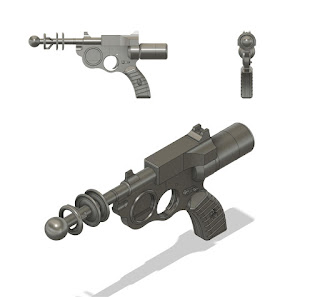Another experiment to try and learn Fusion360 - I just started 3Doodling around and ended up with a sci-fi rifle
My initial plan was to print it out full size as a prop, so I started by printing the hand grip, to make sure that
a) I was at the correct scale, and
b) It wasn't cripplingly uncomfortable to hold
First print - slightly too small
Second print - slightly too large
Third print - the size was right, but the end result was NOT comfortable to hold - the gap between the trigger finger & the other fingers was too big, the separate finger groves were uncomfortable, and the thumb hole was awkward.
 |
| left to right - too small, too big, right scale but uncomfortable |
At this point, I went back to Fusion360 and redesigned the grip section. I also decided to try printing out a 1:3 scale version, before I decided if I wanted to commit to printing a full-sized prop.
 |
| one DIY model kit - instructions not included |
After plenty of sanding, to fix my mistakes (don't leave uncured prints in IPA too long - they swell up and wont fit together without some... persuasion), I was able to glue the prints together
After filling the gaps, and sanding the filler, (repeat as necessary, it was time to prime and paint)
Colour choice was mainly dictated by the red and grey spray cans I had lying around - a decision that in retrospect may have been a mistake (the paint added a pretty hefty texture, and didn't adhere well to the silver undercoat). As a result, I heavily weathered the finished piece to try and hide the crimes
 |
| Final details were added by hand, using a paintbrush |
|








